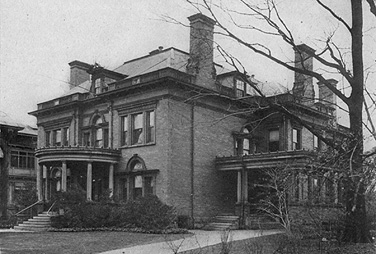Flashback
90 years ago
A club for UB alumni

The Alumni Club was located in the Hayes residence at 147 North St. Photo: UB ARCHIVES
At a dinner at the Buffalo Club hosted by UB Council Chair Walter P. Cooke on Dec. 5, 1921, 100 alumni adopted a resolution that would lead to the establishment of a club for graduates of the university. The Alumni Club of the University of Buffalo was born.
UB’s first university-wide alumni organization was established in 1915 as the Federated Alumni Association; the name was changed to the Alumni Association of the University of Buffalo in 1926. The Alumni Club, established in 1921, began as an independent entity and not part of that organization.
A fund drive held in February 1922 netted $8,000 from 800 graduates. With those funds and a hefty mortgage, ownership of the home of the late Edmund M. Hayes transferred to the Alumni Club.
The club was formed to promote loyalty among alumni as part of an effort to create the “greater university.” Under Cooke’s leadership, UB had conducted a successful capital campaign in 1920. Organizing a club for alumni with an impressive venue for its activities was another way in which Cooke sought to promote the concept of the “greater university.”
Shaded by lofty elms, the Hayes residence at 147 North St. sat well back from the street, with a lot extending 600 feet. The grounds had been designed by Frederick Law Olmsted. The area occupied by the house is now the parking lot and garden of UB’s Jacobs Executive Development Center, formerly the Butler Mansion, at 672 Delaware Ave.
There was ample space in the house for reception rooms, reading rooms, a library, card rooms, billiard room and an assembly hall. More than 2,000 meals were served each month.
With the goals of promoting social interaction among members and developing an alumni spirit, a broad range of activities were planned. The “Alumni Club Tatler” was mailed to members announcing dances, card parties and theme parties scheduled for the coming week.
There was entertainment to meet all tastes, from amateur boxing to opera. Tournaments were conducted in pool, bridge, chess and checkers, and members also could try their luck with a card game called Russian Bank. While membership was restricted to men, there was a weekly “ladies night” and dinner dances were held on the last Thursday of each month.
Not unlike other organizations, the Alumni Club was affected by the dire financial conditions in Buffalo and throughout the country in 1929.
Unsuccessful in obtaining a bank loan, the club sold part of the property to cover taxes and outstanding interest on the mortgage. The buildings and remaining land were appraised at $120,000. No prospective buyers came forward.
With membership a luxury that many men could no longer afford, revenue plummeted and the club defaulted on the mortgage.
Tuyn’s restaurant was located in the house for many years before the building was demolished. After 1931, the Alumni Club became a group devoted to raising money for scholarships and no longer a social organization.
The University Archives hold extensive records for UB alumni organizations at the university and individual school levels. In 1926, the Alumni Association of the University of Buffalo began a quarterly publication for graduates of all divisions of the university. Issues of the publication from 1926 through August 1962 are available online as part of the “Best of the UB Archives.”
—John Edens, University Archives

Reader Comments
Shonnie Finnegan says:
This has been such an excellent series. I think many readers will miss it now that John Edens is retired and there are no evident plans to replace him as university archivist or to hire other archivists to replace the ones who have left or retired.
Posted by Shonnie Finnegan, University Archivist Emerita, 12/22/11